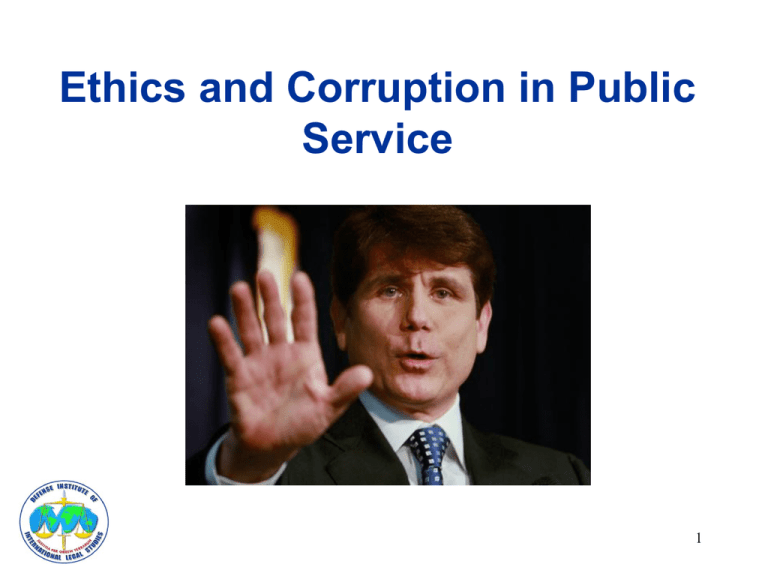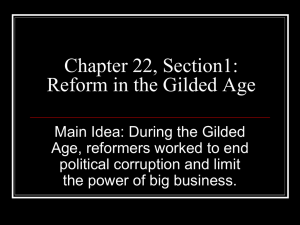Ethics and Corruption in Public Service
advertisement

Ethics and Corruption in Public Service 1 CHALLENGES OF PUBLIC SERVICE • Large scale problems Drug Trafficking • Transcend borders • Stress limited resources Terrorism • Require knowledge and skill Human Trafficking 2 DOMESTIC AND TRANSNATIONAL • Provision of domestic public services • Transnational challenges – Organized crime and terrorism – Poverty and disease – Environment and resources – Interconnectivity and technology 3 STABILITY AND ORDER • Regional conflicts • National insurrections • Rogue organizations • International response • Funding and manning issues • Human rights: order vs. individual / group freedoms 4 ETHICS • Principles and values that guide public and private conduct • Personal, collective, professional, societal dimensions • Go beyond criminal law • Involved everyday in public administration and policy making 5 Darleen Druyun MILITARY • Professional v. personal obligations • Administration of arms, supplies, equipment, and personnel • Command over subordinates Darlene Druyun Former Principal Deputy Undersecretary of the Air Force for Acquisition • Control over missions 6 CORRUPTION • Abuse of entrusted power • Public or private actors • “According to the rule” or “against the rule” • Grand v. petty • Organized v. unorganized • Systemic v. localized • Political v. administrative • Linked to other criminal activities 7 Demonstrations in Kyrgyzstan CORRUPTION • Can occur in any public context • Many forms: – Bribery, extortion, embezzlement – Kickbacks, self-dealing – Under-assessments – Coerced donations – Nepotism and cronyism – Ghost employees – “Grease” payments Former U.S. Congressman Dan Rostenkowski 8 PERCEPTIONS OF CORRUPTION Source: Transparency International Global Corruption Barometer 2010 9 CAUSES OF CORRUPTION 10 DISPELLING MYTHS • Poverty is not the same as corruption • Corruption is not a necessary characteristic of developing nations • Corruption does not result in efficiency 11 CORRUPTION MATTERS • Distorts social, economic and political decisions • Diverts scarce resources • Suspends rule of law • Impedes skill development • Encourages deception • Discourages development and investment • Threatens democracy 12 DEVELOPMENT FUNDED SCHOOL 13 ACTUAL SCHOOL 500 FEET AWAY 14 ACTUAL USE OF FINANCED BUILDING 15 REFORM • High-level commitment? • Enforcement power? • Overcome entrenched resistance? • Coordination, specificity, and regular application? • Realistic promises and expectations? • More than textual changes? • Institutional mechanisms? 16 What type of corruption is this? 17 …and this? 18 ACTIVITIES PRONE TO CORRUPTION • • • • • Privatization Large-scale public works projects Defense spending Revenue collection (customs) Licensing and permitting 19 SECTORS PRONE TO BRIBERY 0 = High Bribery; 10 = Low Bribery Agriculture – 5.9 Light Manufacturing – 5.9 Fishery – 5.9 IT – 5.1 Forestry – 5.1 Civilian Aerospace – 4.9 Banking & Finance - 4.7 Heavy Manufacturing – 4.5 Pharmaceuticals/Medical Care – 4.3 Transportation/Storage – 4.3 Mining – 4.0 Power Generation/Transmission 3.7 Telecommunications – 3.7 Real Estate/Property – 3.7 Oil & Gas – 2.7 Arms & Defense – 1.9 Public Works & Construction – 1.3 Note: Respondents were asked, “Which are the sectors in your country of residence where senior public officials would be very likely, quite likely or unlikely to accept bribes? TI estimates the standard error to be 0.2 or less. Conducted by Gallop in 15 Emerging Market Countries. Source: Transparency International’s Global Corruption Report 2003 20 CAUSES OF CORRUPTION INSTITUTIONAL SOCIETAL WIDE AUTHORITY POVERTY & CONFLICT LITTLE ACCOUNTABILITY PERVERSE INCENTIVES CORRUPTION PERSONAL LOYALTIES ILLEGITIMATE GOVERNMENT 21 AN ILLUSTRATION If there is no possibility that anyone will know 33% Report and Return Funds 50% Undecided 17% Keep Option Finder Results: Various Audiences 22 AN ILLUSTRATION CONTINUED If there is a 30% probability that you will be observed 22% Undecided 4% Keep 74% Report and Return Funds Option Finder Results: Various Audiences 23 CONCLUSION • Anti-corruption efforts: – Foster culture of principled conduct – Create institutional mechanisms for prevention, detection and punishment 24 25











